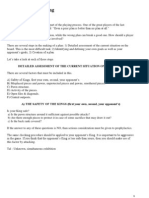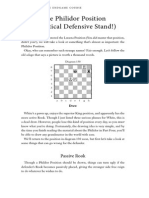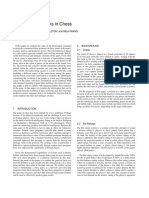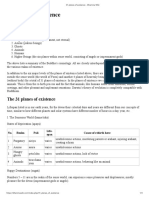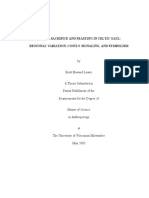Heisman 15
Heisman 15
Uploaded by
religioncubaCopyright:
Available Formats
Heisman 15
Heisman 15
Uploaded by
religioncubaCopyright
Available Formats
Share this document
Did you find this document useful?
Is this content inappropriate?
Copyright:
Available Formats
Heisman 15
Heisman 15
Uploaded by
religioncubaCopyright:
Available Formats
Novice Nook
Novice Nook
Dan Heisman
A Counting Primer
Dans quote of the month: It does not matter who gets the advantage
out of the opening if one of the players is likely to lose a piece to a
simple tactic in the middlegame. Losing a piece from an advantageous
position will almost always result in a losing position. So study tactics,
not openings, until you almost never lose pieces to simple tactical
motifs.
If you have read previous Novice Nooks, you may recall that I list four
primary levels of tactics. Tactics can be considered the science of
chess piece safety, with the goal of winning material/mating or,
equally importantly, using/avoiding tactics defensively to prevent loss
of material or mate:
1. en prise (leaving pieces where they can be captured but not
recaptured)
2. counting
3. single motif tactics
4. combinations
Counting is the process of determining whether any sequences of
captures on a square might lead to loss of material. If not, the piece on
the square is considered safe.
Most beginner books bypass counting and jump right into single motif
tactics: pins, double attacks, removal of the guard, etc. Yet most
players under 1400 are very susceptible to making counting errors that
cost them games. These errors may be due to the fact that they
misunderstand the value of the pieces, or just miscalculate.
The Value of the Pieces
For those who missed IM Larry Kaufmans award-winning article in
Chess Life on piece value, the best average piece values to use are:
knights and bishops are worth about 3.25 pawns (not points!), rooks 5,
file:///C|/Cafe/heisman/heisman.htm (1 of 11) [04/14/2002 4:57:21 PM]
Novice Nook
and queens 9.75. Pawns, of course, are worth 1. Having the bishop pair
(when you have both bishops and your opponent does not) is worth a
bonus of about 0.5 pawns. So trading a knight and bishop for a rook
and pawn loses about half a pawn, but if in doing so you also lose the
bishop pair, you lose a total of about 1 pawn, which is approximately
what it takes for one master to beat another! For example, consider the
following common beginner sequence: 1. e4 e5 2. Nf3 Nc6 3. Bc4 Bc5
4. O-O Nf6 5. Ng5?! O-O 6. Nxf7? Rxf7 7. Bxf7+ Kxf7:
A beginner playing White might
mis-evaluate: I have given up a
bishop and knight for a rook and
pawn so each side has traded six
pawns, but his king is exposed, so I
am winning. An experienced
player with the Black pieces should
evaluate: White has given up a
bishop and knight for a rook and
pawn, so I am ahead half a pawn
(6.5-6), but I also have the bishop
pair, so that makes it one pawn
ahead, and am ahead about 3 tempos, worth almost another pawn for a
total of almost two pawns ahead. My king is safer than his since I can
get pieces there quickly while he has nothing that can harass mine, so I
am pretty much winning. This situation is entirely due to Whites
initial counting error of the trade on f7 (as well as his
misunderstanding of other aspects of the position).
A similar mistake is thinking that winning The Exchange (a rook for
a bishop or knight) is worth two full pawns when in fact it is only
worth about half a piece, and even less if you lose the bishop pair in
the process. Getting a pawn and the bishop pair is almost worth the
exchange by itself, and in many positions is worth more. Many weak
players clearly overrate the exchange; I wish I had a nickel for every
time I saw a beginner voluntarily lose a piece (!) instead of the
exchange because he did not want to lose a rook (sic)! So it is worth
repeating: It is much better to lose a rook for a piece (the exchange),
than a piece for nothing! As noted above, it is only about half as bad.
Within two hours after writing the above lines, I was watching a
student playing Black on the Internet Chess Club. He reached the
following position:
file:///C|/Cafe/heisman/heisman.htm (2 of 11) [04/14/2002 4:57:21 PM]
Novice Nook
A few moves before he had been
winning easily, ahead three pawns.
However, instead of heeding the
advice from my column two
months ago (on How to play when
you are way ahead, such as
keeping things simple) he had met
an attack with a counterattack, the
position got a little complex, and
now he had to lose material. The
good news was that he would still
be ahead, as after the routine
1Bf3 2. Nxd6 exd6 he has the bishop pair and three pawns for the
exchange with an easy win still likely. Instead he hesitated - you
could almost hear him thinking dont lose the rook! - and played
1Rd3?? After 2. Rxg2 he now had a very bad position and soon lost
on time. If I had a nickel for every time I saw this miscount happen I
probably would be writing Novice Nook from a villa in France
(anyone got one to invite me?).
The following is an example of an exchange sacrifice that strong
players make routinely, but weak players usually dont even consider:
The above position is from Keres-
Bronstein, Moscow 1956, with
Black to move. Bronstein
continued 18Rxf3! 19. gxf3
Nxd4 and already Black is a little
better, not down a pawn as a
simple rook is worth 5, knight
plus pawn worth 4 evaluation
would have you believe. I call the
older 3 pawns for a bishop and
knight Reinfeld values since so
many chess books in English in the
1950s and 1960s were beginner books by Fred Reinfeld. Reinfeld
values are great to teach beginners, but if you are going to be a good
player you are going to have to graduate from them, or at least not
follow them slavishly.
Counting Exercises
There are exercises that can enhance a players ability to see whether
or not a trade of pieces is favorable. I suggest that any beginner should
file:///C|/Cafe/heisman/heisman.htm (3 of 11) [04/14/2002 4:57:21 PM]
Novice Nook
start with these before they ever do any more advanced tactical
exercises; adequate counting is a prerequisite for doing tactical motif
(pin, double attack, removal of the guard) problems. We will start with
the most basic examples (similar to those in Everyones 2
nd
Chess
Book) and any instructor will be able to set up some more if you need
them. These exercises start out very simple, but stick with them I
think most of my readers will learn something!
In each of the next 9 problems the question will be, White to move;
is the pawn on d3 safe? Note that the Kings are intentionally left off
the board so that you dont try other moves we are just concentrating
on captures on d3, and thus only the safety of the pawn on that square.
White to move: Is the Black
pawn safe?
The answer is, of course, no. 1.
Rxd3 would win the pawn. Too
easy, you say? True, but let us
build up the difficulty one step
at a time. Since the pawn is
attacked once and it is guarded
zero times, you can win it. This
is actually the first level of
safety, en prise since the pawn
can be taken for free. En prise involves counting in a trivial sense
where the attackers count is one or more and the defenders count
is 0!
Now the answer is yes, the pawn
is safe. After 1. Rxd3? Rxd3
Black would be ahead by four
pawns on that trade: (R=5)
(P=1) = 4 pawns ahead for
Black. Therefore White, with
the freedom to make any move
he wanted, would almost
undoubtedly not want to take the
pawn. We can see from this
example that if a piece or pawn
is guarded as many times as it is
attacked, it is safe from capture as long as all the guarding pieces
have the same value (which, as we shall see shortly, is not always
file:///C|/Cafe/heisman/heisman.htm (4 of 11) [04/14/2002 4:57:21 PM]
Novice Nook
the case!).
Now the answer is back to no.
After 1. Raxd3 Rxd3 (moving
the Rook away instead of
recapturing also leaves Black a
pawn behind) 2. Rxd3 White
wins a pawn so it is not safe.
Notice here it is attacked twice
and defended once, all by pieces
of the same value, so that is an
indication that it is not safe.
The answer in the above is yes,
it is safe. After 1. Raxd3?
Rxd3 2. Rxd3 The alternative
of not recapturing still does not
help White. After 2...Rxd3
Black is again ahead four
pawns.
The answer is still yes, the pawn
is safe. Substituting a Queen for
the Black Rook behind the pawn
makes no difference, because
the Queen can capture last:
After 1. Raxd3? Rxd3 2. Rxd3
Qxd3 Black is again up four
pawns. But with just a simple
switch
file:///C|/Cafe/heisman/heisman.htm (5 of 11) [04/14/2002 4:57:21 PM]
Novice Nook
All of a sudden the problem
isnt so trivial! With the Queen
in front of the Black Rook, any
recapture must give up the
Queen: After 1. Raxd3 Qxd3 2.
Rxd3 Rxd3 Black has captured
two Rooks (2 x 5 = 10), but had
to give up a pawn and a Queen
(9.75 + 1 = 10.75), so the trade
is just slightly better for White,
although the answer depends to
a large extent on where the rest
of the pieces are! In this case the pawn is often considered safe
(since the Queen value may vary so much by position), but a
valuable lesson is learned it matters what order you can capture
(or re-capture) when determining whether a piece is safe.
The above example shows that
the attackers initial order of
capture also matters. The pawn
is not safe as long as White
properly begins his capturing
sequence with his lowest valued
piece, the Knight: 1. Nxd3 wins
the pawn. Notice that Black
would be foolish to recapture, as
1Rxd3 2. Qxd3 wins the
pawn and the exchange. In that
case White captures 5+1 = 6;
Black captures 3.25, so Black loses 2.75 instead of the 1 he would
have lost if he had not recaptured. Remember, you are never forced
to recapture! Chess is not checkers. Young beginners often make
the mistake of making all possible captures on a square once one
has been initiated. Of course, if White had captured with the Queen
first, that would be a huge mistake, as after 1.Qxd3? Rxd3 2.Nxd3,
White would lose the equivalent of 3.75 pawns a Queen (9.75) for
a Rook and pawn (5+1).
file:///C|/Cafe/heisman/heisman.htm (6 of 11) [04/14/2002 4:57:21 PM]
Novice Nook
All of Whites pieces are ready
to capture Blacks pawn on d3,
but it is safe no matter how
many times it is attacked by
higher valued pieces, because
the combined value of the
defending piece the pawn at
c4 and the attacked piece the
pawn at d3 is less than the
value of any piece that can take
it. So any capture on d3, such as
1. Nbxd3? cxd3 2. Nxd3, will
cost White the equivalent of 3.25 pawns (a Knight), while winning
only two. Yes, White can capture the pawn on c4, which is not
guarded by 1. Nxc4, but that was not the question!
This very important example
shows that you just cannot count
up the value of all the pieces that
would be capturing on the square
(except one never counts the final
piece, which captures last and is
not taken off the board). White
should play 1. Bxd3, and if Black
plays 1Qxd3?, then White
should play 2. Rxd3 Rxd3 and
then White should not recapture,
but instead move his Queen to
safety, coming out about 1.5 pawns ahead (getting 9.75 and giving up
3.25+5). If White continues 3. Qxd3? Rxd3, then White would have
given up 3.25+5+9 = 17.25 and only gotten 1+9.75+5 = 15.75, losing
1.5 pawns instead! So the pawn is not safe. This example once again
shows that you should only do as much exchanging on a square that is
favorable to you; any further exchanges that are not favorable are not
forced and thus should be avoided.
More Counting Examples
You might have read all of the above d3 examples and said to
yourself: I did not learn anything. None of the counting problems that
were discussed would ever happen to me. Unless you are a very
strong player, you are very likely wrong such miscounts happen all
the time in the games of my students. Consider the following type of
file:///C|/Cafe/heisman/heisman.htm (7 of 11) [04/14/2002 4:57:21 PM]
Novice Nook
counting error that occurred in a slow game of one of my students,
who is by no means a weak player.
In order to best illustrate the problem I have again removed the
irrelevant pieces from his position, but material was even (Black is not
down a piece since the diagram below only represents a fraction the
relevant part - of the actual position). White has just played 1. Bg4
attacking the Queen:
Black safeguards the Queen by
playing 1Nxg4. What should
White do?
White played the counting error
2. Qxf5? This zwischenzug
allowed Black to recapture
2gxf5 and then, when White
finally captured back with 3. hxg4,
Black had an extra attacker on g4
and was now able to win a pawn
with 3fxg4. Black, up a pawn,
went on to win the endgame. Instead White should simply have
recaptured on g4 with the Queen or the pawn (2. Qxg4 or 2. hxg4), and
material would have been even. What is more amazing is that when
going over this game with my student, he was unaware that his
capturing sequence lost a pawn!
Combined with tactical motifs, especially removal of the guard,
counting in some positions can be extremely complicated as
complicated as any other combination, since it now becomes part of a
multiple-motif calculation. Consider the following example given from
IM John Watsons superb work Secrets of Modern Chess Strategy
(notes based on Watson and Fritz 7):
file:///C|/Cafe/heisman/heisman.htm (8 of 11) [04/14/2002 4:57:21 PM]
Novice Nook
This is Szabo-van Seters,
Hilversum 1947, after Blacks
move 16Rd7. Can White safely
play 17. d5? This is not easy at all.
I am not asking whether 17. d5 is a
good move that is even harder! I
am just asking whether playing 17.
d5 loses material in any line.
The game continued: 17. d5! At 11
ply, Fritz7 rates this as clearly best,
with White evaluated as better by
almost a pawn. White actives his central forces. Watson writes: This
pawn-break epitomizes Whites strategy, and its playability Note
his word playability in some senses he means that it is a safe
move! 17Nxd5 Fritz rates this as a mistake, but even after the
improvements 17Qb8 or 17h6, White is much better. 18. Bxd5!
This is superior to the alternative 18. Nxd5. 18Qd8? Fritz says the
only move that even stands a chance is 18h6. 19. Qe4 This wins, but
Watson does not mention that 19. Bxe7 Nxe7 20. Ng5 is even more
advantageous! 19exd5 Better, but not sufficient to save the game, is
19Bxg5 20. Bxe6! 20.Nxd5 It is apparent that White has a massive
attack. 20Bxg5 21. Nxg5 g6 22. Qh4 h5 Now a simple fork with the
underrated tactic removing the guard wins the exchange: 23. Nf6+
Qxf6 24. Rxd7 Nd8 25. Re8+ Kg7 26. Rxf7+ Fritz does not rate this
as one of Whites three best moves, but any move that is sufficient to
cause resignation is probably good enough!: 1-0
I see counting errors by players of even intermediate tournament
strength, so the bottom line is that it pays to know how to count
correctly, and to do it every time. It is not an easy skill by any means,
and a quite underrated one. I rarely see discussions about chess
improvement refer to counting, but no discussion about how to get
good at chess should overlook how to learn and practice this important
skill.
Reader Question
My greatest weakness is the opening. Any suggestions?
Answer
I think my answer should help everyone who worries about this. First,
my suggestions depend upon your level of play. For very weak
players just get your pieces out safely. For not-so-beginners:
file:///C|/Cafe/heisman/heisman.htm (9 of 11) [04/14/2002 4:57:21 PM]
Novice Nook
1. Understand the three main goals of the opening: Mobilize ALL your
forces, castle your king into safety, and get some control of the center.
Of course the overall goal is to reach a playable middlegame where
your forces have good things to do.
2. Learn the general opening principles that apply to all openings to
help you reach those goals. The most important is to develop your
pieces quickly and efficiently. When in doubt use the guideline:
Except where safety dictates, move every piece once before you
move any piece twice! The second most important is to learn the
concept of break moves (moves like c5 in the French or f5 in
the main line Kings Indian) which break down your opponents pawn
chains and thus gain space and force open lines for your rooks and
other pieces. One source of this type of maneuver is Hans Kmochs
Pawn Power in Chess. He has his own nomenclature, but his concepts
are great; I think he calls break moves something like liberating
levers. This concept is so important that I will devote a future Novice
Nook to break moves.
3. Play sharp openings, like gambits, to learn tactics. If you are not
good at tactics, that is all the more reason to do so!
4. Buy Nunn's Chess Openings or MCO-14, and
A) Learn how to use it so it is easy to look things up. Many of my
students avoid using such opening encyclopedias just because they
dont take 5-10 minutes to figure out how to read them!
B) Learn the traps in the openings you play the ones that win for
you, but especially to avoid the ones that lose for you.
C) Look up the games you play after you play them to see "What
would I do differently if an opponent played the same moves in a
future game?", and
D) Don't spend a lot of time studying specific lines - use that time to
study tactics instead. If you must study specific lines, first learn the
main line and then over time you can branch out to greater width.
5. Look at games played by good players in your opening to see what
the ideas are in the openings you choose: where the pieces usually go,
where the pawn breaks are, where to attack in the middlegame, etc.
file:///C|/Cafe/heisman/heisman.htm (10 of 11) [04/14/2002 4:57:21 PM]
Novice Nook
6. If your opponent does something you have never seen before, don't
panic, but don't assume that you can just going on doing what you
were going to do; sometimes that is great and other times disastrous.
But this will happen so often that you will wish you had not spent so
much time studying specific lines, so dont!
7. Don't worry too much about openings - it is probably the least
important part of chess except for knowing note #1.
Once you are rated over 1300 USCF/FIDE, then specific opening
study should be expanded, but my personal belief and that of many
experienced instructors is that spending a large amount of time
studying specific opening lines is not a really efficient use of your
chess study time until you approach a rating of at least 1800-2000
Copyright 2002 Dan Heisman. All rights reserved.
Dan teaches on the ICC as Phillytutor.
Order Dan's new book A Parent's Guide to Chess
[The Chess Cafe Home Page] [Book Reviews] [Bulletin Board] [Columnists]
[Endgame Studies] [The Skittles Room] [Archives]
[Links] [Online Bookstore] [About The Chess Cafe] [Contact Us]
Copyright 2002 CyberCafes, LLC. All Rights Reserved.
"The Chess Cafe" is a registered trademark of Russell Enterprises, Inc.
file:///C|/Cafe/heisman/heisman.htm (11 of 11) [04/14/2002 4:57:21 PM]
You might also like
- Novice Nook's Chess Lists - Heisman31 PDFDocument11 pagesNovice Nook's Chess Lists - Heisman31 PDFAnonymous kdqf49qbNo ratings yet
- Heisman 39Document8 pagesHeisman 39initiative1972No ratings yet
- Choosing An Opening Repertoire - Exeter Chess Club PDFDocument8 pagesChoosing An Opening Repertoire - Exeter Chess Club PDFNjabulo Jiniyas SibisiNo ratings yet
- Scandinavian Defence: Winning With 2...Nf6 (Revised Edition)From EverandScandinavian Defence: Winning With 2...Nf6 (Revised Edition)No ratings yet
- Blunder Buster - Vol 1, Issue 3Document7 pagesBlunder Buster - Vol 1, Issue 3subashNo ratings yet
- Novice Nook: Tactical Sets and GoalsDocument6 pagesNovice Nook: Tactical Sets and GoalsPera PericNo ratings yet
- Novice Nook: Analysis TipsDocument6 pagesNovice Nook: Analysis TipsZAAAjgt86bhgvcfNo ratings yet
- Novice Nook: The Theory of Chess ImprovementDocument9 pagesNovice Nook: The Theory of Chess Improvementinitiative1972No ratings yet
- Novice NookDocument9 pagesNovice NookAbhishek Vyas100% (1)
- Novice Nook: Principles of Analytical EfficiencyDocument5 pagesNovice Nook: Principles of Analytical EfficiencyPera Peric100% (1)
- Novice Nook: Time Management TalesDocument10 pagesNovice Nook: Time Management Talesinitiative1972No ratings yet
- Bains Rating Tactics QuizDocument7 pagesBains Rating Tactics QuizPaul DoireNo ratings yet
- Taking Advantage of Weak Opening MovesDocument14 pagesTaking Advantage of Weak Opening MovesVon Greggy Moloboco IINo ratings yet
- Novice Nook: Learning From Dr. de GrootDocument10 pagesNovice Nook: Learning From Dr. de Grootআরিফ রহমান সৈকতNo ratings yet
- Dynamic Pawn Play in ChessDocument4 pagesDynamic Pawn Play in ChessMarco Antonio TavaresNo ratings yet
- Choosing The Right Chess Openings For Beginners - 3 Key TraitsDocument11 pagesChoosing The Right Chess Openings For Beginners - 3 Key TraitsStarmyx WalkerNo ratings yet
- Book Recommendations by Mark KaprielianDocument6 pagesBook Recommendations by Mark Kaprielian3187265No ratings yet
- A - Chess Improvement-A !!!!!Document33 pagesA - Chess Improvement-A !!!!!JoshuaCanasta100% (2)
- Dan Heisman Chess ArticleDocument12 pagesDan Heisman Chess Articlesg1964No ratings yet
- An Endgame Expert: by GM Igor SmirnovDocument10 pagesAn Endgame Expert: by GM Igor SmirnovMarcosm06No ratings yet
- Heisman19 PDFDocument13 pagesHeisman19 PDFApostolopoulos Spyros100% (1)
- Lesson 8 PDFDocument9 pagesLesson 8 PDFRitesh AgarwalNo ratings yet
- Lesson 1Document6 pagesLesson 1Marcosm06No ratings yet
- Novice Nook: Using The Computer To ImproveDocument10 pagesNovice Nook: Using The Computer To ImproveAbhishek VyasNo ratings yet
- Best Chess Openings For Beginners at PDFDocument1 pageBest Chess Openings For Beginners at PDFDavid OspinaNo ratings yet
- Academic Chess Opening Help SheetDocument2 pagesAcademic Chess Opening Help SheetqwdfghNo ratings yet
- Dy Namic Chess Strat Egy: An Ex Tended and Up Dated EditionDocument9 pagesDy Namic Chess Strat Egy: An Ex Tended and Up Dated Editionspitfire_markix0% (1)
- 64 Commandments of ChessDocument2 pages64 Commandments of ChessLindsay Rene Otto100% (1)
- 144 Annotated Chess GamesDocument2 pages144 Annotated Chess GamesWalter Acosta0% (2)
- Ten Step To Chess Tactics CourseDocument84 pagesTen Step To Chess Tactics CourseNyan Lin ThetNo ratings yet
- The Ideas Behind The Chess Openings FineDocument22 pagesThe Ideas Behind The Chess Openings FineaksNo ratings yet
- Novice Nook: Break Moves: Opening Lines To Increase MobilityDocument10 pagesNovice Nook: Break Moves: Opening Lines To Increase Mobilitylol364No ratings yet
- Thinking CAPDocument37 pagesThinking CAPAnonymous CPQKqCVPP1100% (1)
- Boost Your Chess 3: MasteryDocument16 pagesBoost Your Chess 3: MasteryccKhaled20% (1)
- Post-Game Study Guide: Prof. Chester Nuhmentz, JRDocument1 pagePost-Game Study Guide: Prof. Chester Nuhmentz, JRa10325826100% (1)
- Basic Chess StrategiesDocument5 pagesBasic Chess Strategiesbluestarandfireheart100% (1)
- Chess Opening Tactics - The French - Advance Variation: Opening Tactics, #3From EverandChess Opening Tactics - The French - Advance Variation: Opening Tactics, #3No ratings yet
- Education of Chess PlayersDocument57 pagesEducation of Chess PlayersKartik ShroffNo ratings yet
- The Secrets To Real ChessDocument4 pagesThe Secrets To Real ChessBassel SafwatNo ratings yet
- Hansen 34Document20 pagesHansen 34fdmbzf100% (1)
- An Endgame Expert: by GM Igor SmirnovDocument10 pagesAn Endgame Expert: by GM Igor SmirnovMarcosm06No ratings yet
- Middlegame Planning: Detailed Assessment of The Current Situation On The BoardDocument20 pagesMiddlegame Planning: Detailed Assessment of The Current Situation On The BoardAnonymous CPQKqCVPP1No ratings yet
- Philidor PositionDocument6 pagesPhilidor PositionTomas VasquezNo ratings yet
- Modern Chess Preparation Part 10Document19 pagesModern Chess Preparation Part 10Said Alauddeen Faisz100% (1)
- Instructive Chess MiniaturesDocument7 pagesInstructive Chess Miniaturesradovanb0% (1)
- 160 Chess Puzzles in Two Moves, Part 5: Winning Chess ExerciseFrom Everand160 Chess Puzzles in Two Moves, Part 5: Winning Chess ExerciseNo ratings yet
- Chess Opening Principles by Six Famous GrandmastersDocument2 pagesChess Opening Principles by Six Famous GrandmastersGopi KrishnaNo ratings yet
- Colle For Students by PRNV SirDocument60 pagesColle For Students by PRNV Sirharshalpatil100% (2)
- Attacker HandbookDocument5 pagesAttacker HandbookStans WoleNo ratings yet
- Chess Simple VariantsDocument14 pagesChess Simple VariantsWkrscribdNo ratings yet
- 50 Strategies To Gain The Upper Hand Over Your OpponentDocument3 pages50 Strategies To Gain The Upper Hand Over Your OpponentKuro NekoxNo ratings yet
- Thought Process in ChessDocument13 pagesThought Process in ChessFrancis A. BuenaventuraNo ratings yet
- Chess AnalysisDocument8 pagesChess AnalysisAnusha100% (1)
- 7-Step Plan To Succeed in Chess in 2024Document17 pages7-Step Plan To Succeed in Chess in 2024Anthony MosquedaNo ratings yet
- Human Resource ManagementDocument57 pagesHuman Resource ManagementIndrajith Nair100% (1)
- Judging A HoroscopeDocument3 pagesJudging A Horoscopeshylashri19No ratings yet
- Why Are Filipinos Good at Singing (DISS PeTa)Document6 pagesWhy Are Filipinos Good at Singing (DISS PeTa)kayeNo ratings yet
- The Lament - 20240514 - 164942 - 0000Document14 pagesThe Lament - 20240514 - 164942 - 0000jolo Del Rosario GeneraoNo ratings yet
- Respond To Emergencies: Hipboard Contingency PlanDocument3 pagesRespond To Emergencies: Hipboard Contingency Planmithilesh seloteNo ratings yet
- Millares Vs NLRCDocument1 pageMillares Vs NLRCJohnde MartinezNo ratings yet
- PD 532 ANTI PIRACY AND HIGHWAY ROBBERYodtDocument2 pagesPD 532 ANTI PIRACY AND HIGHWAY ROBBERYodtDawn JessaNo ratings yet
- Federalist 10 Excerpt and QuestionsDocument2 pagesFederalist 10 Excerpt and Questionsapi-281321560No ratings yet
- Role of PCR Testing in Monitoring Asymptomatic COVID-19 CarriersDocument5 pagesRole of PCR Testing in Monitoring Asymptomatic COVID-19 CarriersBiogxincNo ratings yet
- Yaseer Arafath Banking System-SbiDocument60 pagesYaseer Arafath Banking System-Sbiisaq49935No ratings yet
- The Three Blind MiceDocument4 pagesThe Three Blind MiceZennith Maiso JazminesNo ratings yet
- Directorate Office Directorate of Education (Govt. of NCT of Delhi) Appointment OrderDocument1 pageDirectorate Office Directorate of Education (Govt. of NCT of Delhi) Appointment OrderManish TomarNo ratings yet
- Nike Strategic Planning DocumentDocument37 pagesNike Strategic Planning DocumentJohn Paolo BelloNo ratings yet
- Boynton SM Ch.09Document15 pagesBoynton SM Ch.09Eza RNo ratings yet
- Lesson 3 - Multiple-Choice QuestionDocument3 pagesLesson 3 - Multiple-Choice QuestionLưu Lê Minh HạNo ratings yet
- A Practice of Corporate Social Responsibility (CSR)Document11 pagesA Practice of Corporate Social Responsibility (CSR)Leslie Monica MacaisaNo ratings yet
- Entrepreneurship Final ModulesDocument179 pagesEntrepreneurship Final Moduleseden gebetaNo ratings yet
- BUENAGUA Aguirre V PhengDocument1 pageBUENAGUA Aguirre V PhengMartin Benjamin Tomelden LagmayNo ratings yet
- 31 Planes of Existence - Dhamma WikiDocument3 pages31 Planes of Existence - Dhamma WikimjfiorelloNo ratings yet
- Middle 140319Document15 pagesMiddle 140319BernewsAdminNo ratings yet
- FM and Service DeliveryDocument3 pagesFM and Service DeliveryrenvNo ratings yet
- Eduardo Hernández Mateos: IameduDocument1 pageEduardo Hernández Mateos: IameduEdu MenNo ratings yet
- Wrongful Restraint and Wrongful ConfinementDocument8 pagesWrongful Restraint and Wrongful ConfinementPb 29 Speaker 1No ratings yet
- Dicionário Ilustrado Infantil FR PDFDocument72 pagesDicionário Ilustrado Infantil FR PDFPaulo BonifácioNo ratings yet
- Official Rules For Calling ShotgunDocument2 pagesOfficial Rules For Calling ShotgunyoshibrainsNo ratings yet
- 24 Tornillos 2022Document22 pages24 Tornillos 2022Miguel Angel Gaytán PérezNo ratings yet
- 1.1a Introduction To Legal Med PDFDocument2 pages1.1a Introduction To Legal Med PDFBea SamonteNo ratings yet
- Animal Sacrifice and Feasting in Celtic PDFDocument242 pagesAnimal Sacrifice and Feasting in Celtic PDFFederico MisirocchiNo ratings yet
- Pryda Catalogue: Timber ConnectorsDocument32 pagesPryda Catalogue: Timber ConnectorsnegomireanuNo ratings yet
- Adverb Comparative Superlative Hard Carefully - Early QuicklyDocument4 pagesAdverb Comparative Superlative Hard Carefully - Early QuicklyAnonymous Hzumgr43FGNo ratings yet














































